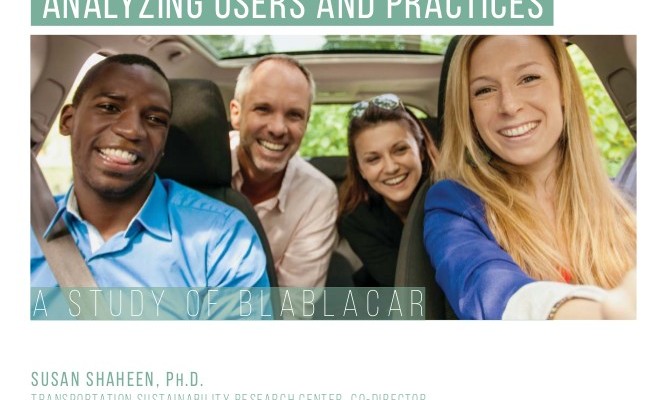Online and App-Based Carpooling in France: Analyzing Users and Practices. A Case Study of BlaBlaCar / Susan Shaheen, Adam Stocker, Marie Mundler
Online and App-Based Carpooling in France: Analyzing Users and Practices. A Case Study of BlaBlaCar / Susan Shaheen, Adam Stocker, Marie Mundler. – Berkeley : Transportation Sustainability Research Center, University of California, July 2016. – 18 p. [formato PDF, 335 kB].
This paper examines the characteristics and practices of ridesharing users in France. In May 2013 the authors surveyed members of BlaBlaCar, the largest online and app-based carpooling service in France, to analyze the socio-demographic characteristics and usage patterns of the respondents. The survey results identify correlations between socio-demographic characteristics and usage elements. Notably, users with a lower income level are more inclined to be passengers, while higher income users employ carpooling mainly as drivers. Students are shown to be more frequent users as well. These findings indicate some equity balancing effects, which may be unique to this shared mobility mode.
The survey showed that carpooling users are on average more educated and younger than the French population (87% of the respondents have a baccalaureate level or more in contrast to only 47% for France, and 45% are under 34 years of age in contrast to 27% for France), although their level of income is relatively similar to the general population. People with a low-income level (defined here as < €10,000 or <$13,449 a year) are represented among carpooling users, along with individuals with an intermediate income level (between €10,000 and €25,000 or $33,620) and a high-income level (> €25,000 or >$33,620). Further analysis reveals some differences in their usage practices. Although not found to be a statistically significant predator of usage frequency, carpoolers with a lower-income level tend to carpool slightly more frequently than carpoolers in the higher-income groups. They also have, on average, fewer alternatives available to them than wealthier users: 8% would not have taken the trip, if carpooling did not exist in contrast to 4% for middle-income and 3% for high-income users. Moreover, respondents with a low-income level are most frequently passengers (54% of them carpool only as passengers), while people with a high-income level are more often drivers (51% carpool only as drivers) and rarely only passengers (12%). The ordinal regression analysis reveals that factors such as work trip purpose, mobile application use, and student status lead to higher BlaBlaCar usage frequency. Meanwhile, respondents in the driver role and those choosing public transit as an alternative mode experience lower usage frequency. Socio-demographic factors, such as age, income, and education, are not statistically significant predictors of frequency, emphasizing that even though many BlaBlaCar members are younger and well educated, these factors alone have little to do with how often individuals use the service.
Because of these differences in carpooling use, we suggest that long-distance carpooling in France reflects a dual practice relative to different population and user segments. Even though it seems safe to say that lower-income users as well as higher-income users gain mobility and accessibility due to carpooling, all categories of income do not have the same range of choice, and for some users, carpooling appears to be the only option. Future research is needed to better understand carpooling in France and how it could be extended to more socio-demographic groups, along with its social and environmental impacts.
